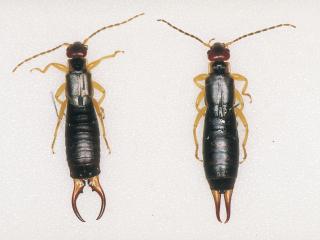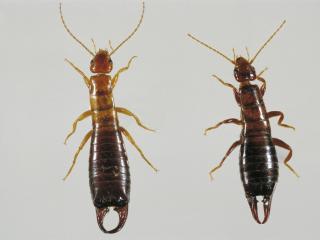European and native earwigs
- Wittenoom Hills
- Hopetoun
Quenten Knight (Agronomy Focus) has recently reported finding European earwigs in volunteer canola near Wittenoom Hills. The paddock was being sown to wheat and the European earwigs varied in growth stages from juveniles to adults.
A grower in the Hopetoun area recently found both European earwigs and native earwigs in paddocks that are about to be sown to canola.
European earwigs are an introduced species and recurring pest on properties that can damage cereal, legume and oilseed crops.
Adult European earwigs range from 12-24mm long. They have uniform brown bodies that are smooth and shiny with light brown/ yellow legs, pincers (also called forceps) and 'shoulders'.
European earwigs should not be confused with native earwigs. European earwigs tend to be found communally whereas native earwigs are usually solitary.
Native earwigs are also widespread in paddocks but feed mainly on leaf litter and other organic material and are not known to damage crops. There are two native earwig species commonly confused with European earwigs: Carcinophora occidentalis (no common name) and Labidura truncata (common brown earwig).
Crop residues on the soil surface increase European earwig survival and breeding, allowing large populations to build up during autumn and early winter and damage crops sown into the stubble.
Earwigs have two breeding cycles per year. One breeding cycle occurs in late winter/early spring and a second in summer.
When checking crops look for shredded leaf tips, or jagged holes in the leaves as this is typical of earwig damage. In severe situations European earwigs can completely defoliate young seedlings leaving only stems or bare ground in patches. This pest is hard to find during the day and it is best to look for European earwigs at night using a torch or by placing pitfall traps into the ground.
Insecticides especially chlorpyrifos or alphacypermethrin applied at the highest registered rates do have efficacy against European earwig as a contact only. However European earwigs can be difficult to control as they hide under stubbles. Sprays applied at night have worked better than sprays applied during the day as earwigs are more active at night. Baiting for European earwigs has provided better control for this pest than spraying, especially in paddocks with heavy stubble loads.
For more information on this pest refer to DPIRD’s Diagnosing European earwig and Management of European earwig pages.
For more information contact Research scientist Svetlana Micic, Albany on +61 (0)8 9892 8591.
Article authors: Cindy Webster (DPIRD Narrogin) and Svetlana Micic (DPIRD Albany).


